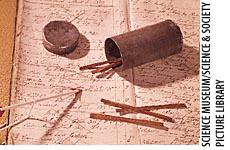 The first friction matches were developed by John Walker (1781-1857)
and were sold from his pharmacy shop located at 59 High Street, Stockton-on-Tees.
Walker often used to make up chemicals for percussion caps, a component
of ammunition. When making a 50:50 mixture of antimony sulphide and KClO3
for a customer, Alton Norton, some drops of the mixture accidentally fell
onto Walker's workshop floor. When walker trod on the dried mixture it
caught fire.
The first friction matches were developed by John Walker (1781-1857)
and were sold from his pharmacy shop located at 59 High Street, Stockton-on-Tees.
Walker often used to make up chemicals for percussion caps, a component
of ammunition. When making a 50:50 mixture of antimony sulphide and KClO3
for a customer, Alton Norton, some drops of the mixture accidentally fell
onto Walker's workshop floor. When walker trod on the dried mixture it
caught fire.
Walker was already making chlorate matches, but he began to experiment with the percussive mixture. He found that his matches would ignite when rubbed along a rough surface. Analysis of some of Walker's friction matches, which survived to the 1920's, showed the match heads to be composed of five parts KClO3, five parts antimony sulphide (Sb2S3), three parts gum Arabic and one part Fe2O3. The matches were known to ignite with a bang.
In the late 1820's Michael Faraday demonstrated a friction match, probably made by Walker, to the Royal Institute in London. Shortly afterwards Samuel Jones began to make friction matches, and sold them from his shop in the strand: he named them lucifers, and this became the generic name for easy-to-light matches. The original lucifer match heads were composed of equal quantities of KClO3, Sb2S3 and glue. The KClO3 acted as the oxidizing agent, while the Sb2S3 acted as the fuel. These lucifers were not ideal as they could be difficult to light, and would on occasion scatter burning fragments; also the ignited match head would not always ignite the matchstick. G. F. Watts found that if the matchsticks were dipped in sulphur they would readily ignite.
Back to the Welcome Page